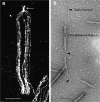The axoneme: the propulsive engine of spermatozoa and cilia and associated ciliopathies leading to infertility
- PMID: 26825807
- PMCID: PMC4759005
- DOI: 10.1007/s10815-016-0652-1
The axoneme: the propulsive engine of spermatozoa and cilia and associated ciliopathies leading to infertility
Abstract
This review article provides a critical analysis of the structure and molecular mechanisms of the microtubule axoneme of cilia and sperm flagella and their associated elements required for male fertility.A broad range of genetic and molecular defects (ciliopathies) are considered in the context of human diseases involving impaired motility in cilia and sperm flagella, providing provocative thought for future research in the area of male infertility.
Keywords: Basal body; Fibrous sheath; Intraflagellar transport; Microtubules; Outer dense fibers; Primary cilia.
Figures







References
-
- van Leeuwenhoek, A. http://lensonleeuwenhoek.net/.
-
- Gray J. The movement of sea-urchin spermatozoa. J Exp Biol. 1955;32:775–801.
-
- Vogl AW, Vaid KS, Guttman JA. The Sertoli cell cytoskeleton. Adv Exp Med Biol. 2008;636:186–211. - PubMed
Publication types
MeSH terms
Grants and funding
LinkOut - more resources
Full Text Sources
Other Literature Sources
Medical

